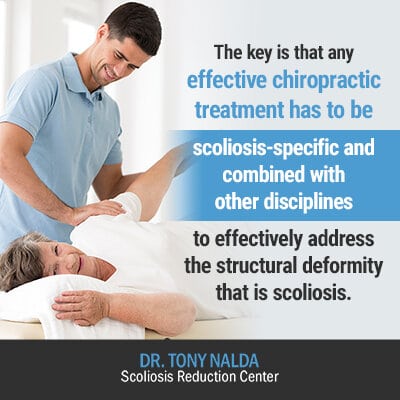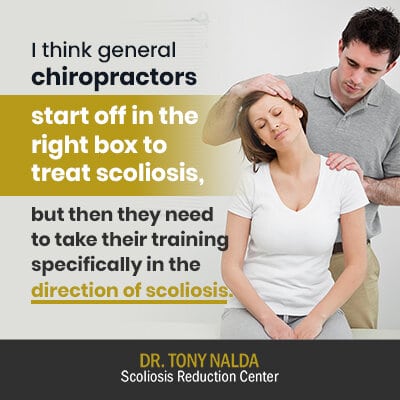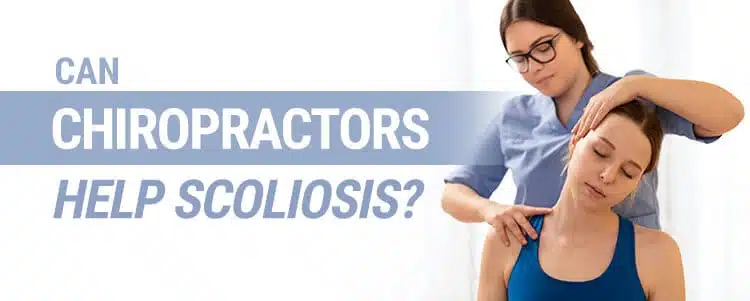Chiropractic is a branch of medicine that focuses on an integrative approach to diagnosing and treating injuries and disorders of the joints and spinal cord. When it comes to scoliosis, chiropractic can help, but chiropractic adjustments alone, more than likely, won’t be enough to reduce a structural scoliosis; however, a chiropractor trained in all components of scoliosis is the best doctor to treat scoliosis because they are trained in multiple scoliosis-related modalities.
As scoliosis is such a complex and highly variable condition, it’s essential that any effective treatment approach is administered by a scoliosis specialist trained in all aspects of the condition and multiple treatment modalities. This is because scoliosis requires an integrative treatment approach that is tailored to each specific condition. Let’s first discuss the difference between general approaches to treatment, and the scoliosis-specific conservative approach, of which chiropractic is an integral component.
General Chiropractic vs. Scoliosis-Specific Chiropractic
There is a big difference between seeking out medical treatment from a general practitioner, or one who is specifically trained in your condition. When it comes to scoliosis, the first thing I tell people is that from the time of diagnosis and throughout the entire course of treatment, choosing your treatment approach and the provider of that treatment, is the biggest choice that will affect your ultimate prognosis.
Here at the Scoliosis Reduction Center®, we follow a conservative treatment approach, and this path integrates multiple disciplines that are scoliosis-specific, not general.
The issue with general chiropractic is that while general adjustments might have the potential to provide some relief from scoliosis-related pain, it does little to address the underlying cause of the condition, which is structural. This represents the difference between treating symptoms of a condition, versus treating the condition itself.
The Traditional Approach vs. the Conservative Approach
Two terms you will hear me toss around are the ‘traditional approach’ and the ‘conservative approach’. These refer to the two main scoliosis-treatment approaches.
The traditional approach has been the dominant treatment approach for hundreds of years, and the chiropractic approach is an alternative method that focuses on a more natural and corrective approach.
On the traditional path, a patient would see their general practitioner for a diagnosis, then likely be referred to a spinal surgeon who would oversee the next portion of their treatment. They would often recommend that mild or moderate cases were simply observed to see if they would get worse.

As scoliosis is a progressive condition, they almost always get worse, meaning progress. Once a condition progressed to a certain point, spinal-fusion surgery would be recommended as the best treatment option.
This means that rods and screws are attached to the spine while it fuses in a straighter alignment. This is a costly and invasive procedure that lacks a lot of data on long-term effects. It also comes at the price of spinal flexibility and carries the risks of hardware failing and subsequent surgeries being needed.
In the conservative approach, this is where working with a scoliosis-specific chiropractor can offer an alternative. Here at the Center, we offer our patients access to multiple forms of treatment: chiropractic, therapy, rehabilitation, and corrective bracing.
Together, these disciplines have the ability to complement one another, and this integrative approach can effectively reduce a spinal curvature at a structural level. This is why we can customize each and every treatment plan to best address the individual characteristics of each patient’s condition.
The key is that any effective chiropractic treatment has to be scoliosis-specific and combined with other disciplines to effectively address the structural deformity that is scoliosis.
Goal of Scoliosis Treatment
As a progressive condition with no known cure, the main goal of scoliosis treatment is to achieve a curvature reduction structurally, and any effective treatment plan has to include sustainability; work will need to be continued to maintain that curvature reduction.
In addition to chiropractic, a doctor who is trained in scoliosis-specific therapy, rehabilitation, and corrective bracing has the training and experience needed to map out customized and scoliosis-specific treatment plans. This conservative approach helps patients benefit from the merits of these different treatment modalities, in addition to avoiding costly and invasive spinal-fusion surgery.
It also means that the chiropractor you are seeking treatment from has the experience and knowledge to comprehensively administer and assess a scoliosis X-ray, which provides the information that becomes the roadmap for treatment.
A big difference between choosing the traditional treatment path and our conservative approach is that the former relies on a surgeon to administer treatment prior to surgery, while the latter involves treatment from a specialist who is trained in all components of the condition, and the multiple forms of treatment it necessitates.
The Path of Treatment

The interesting thing to me, about the path of treatment for someone on the traditional route, meaning they are likely being funneled towards spinal-fusion surgery, is that not everything is being done to see if other forms of treatment could be effective.
An average chiropractor, just like an average medical doctor, isn’t trained in all the treatment measures for scoliosis, its progression, and the condition’s underlying cause.
If a person opts for the traditional path of treatment and sees their general practitioner for a diagnosis, it’s a surgeon that is next in charge of administering any form of treatment, conservative or otherwise, and this is illogical to me.
A surgeon spends their entire life and training learning how to effectively put rods and screws into peoples’ spines, but then they are also put in charge of treating patients’ scoliosis; it’s impossible to effectively learn both approaches.
With the amount of time and energy it takes to become an expert in the conservative scoliosis-treatment approach, it would simply be impossible to learn both effectively.
I think general chiropractors start off in the right box to treat scoliosis, but then they need to take their training specifically in the direction of scoliosis.
What they need is more specific training in how scoliosis differs from a typical chiropractic patient with subluxation or a spinal injury. If they go down this path, chiropractors become the best doctors to assess and treat scoliosis.
Conclusion
When it comes time to choose the path and doctor to treat your scoliosis, or the scoliosis of a loved one, I highly recommend seeking out the help of a scoliosis specialist.
The condition is not an easy one to treat or understand. It takes training in multiple modalities and many hours of study to fully understand the condition, how it progresses, and how best to treat it.
Any general discipline will fall short; it’s only those specifically tailored towards scoliosis that have the power to induce a structural change and effectively treat the condition.
When it comes to chiropractic, general chiropractic is a good place to start on the path to becoming a scoliosis specialist, but that general discipline has to branch off in the direction of scoliosis-specific training and study to fulfill its potential as an effective form of scoliosis treatment.
I saw the lack of effective scoliosis-treatment options as a flaw that I wanted to remedy, and did so with the creation of the Scoliosis Reduction Center®. Each and every patient that walks through our door gets the benefit of a truly customized approach designed by a specialist specifically trained in scoliosis-specific chiropractic and multiple modalities.





